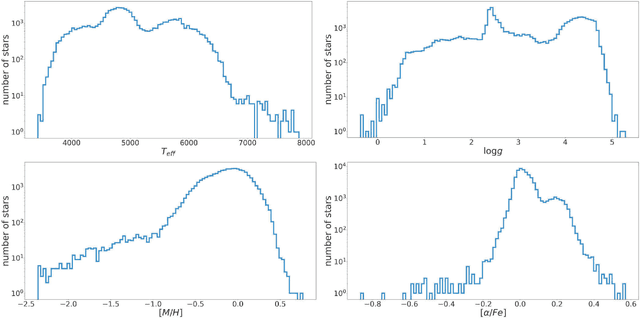Manuel G. Penedo
Disentangling stellar atmospheric parameters in astronomical spectra using Generative Adversarial Neural Networks
Jan 20, 2025



Abstract:A method based on Generative Adversaria! Networks (GANs) is developed for disentangling the physical (effective temperature and gravity) and chemical (metallicity, overabundance of a-elements with respect to iron) atmospheric properties in astronomical spectra. Using a projection of the stellar spectra, commonly called latent space, in which the contribution dueto one or several main stellar physicochemical properties is minimised while others are enhanced, it was possible to maximise the information related to certain properties, which can then be extracted using artificial neural networks (ANN) as regressors with higher accuracy than a reference method based on the use of ANN trained with the original spectra. Methods. Our model utilises autoencoders, comprising two artificial neural networks: an encoder anda decoder which transform input data into a low-dimensional representation known as latent space. It also uses discriminators, which are additional neural networks aimed at transforming the traditional autoencoder training into an adversaria! approach, to disentangle or reinforce the astrophysical parameters from the latent space. The GANDALF tool is described. It was developed to define, train, and test our GAN model with a web framework to show how the disentangling algorithm works visually. It is open to the community in Github. Results. The performance of our approach for retrieving atmospheric stellar properties from spectra is demonstrated using Gaia Radial Velocity Spectrograph (RVS) data from DR3. We use a data-driven perspective and obtain very competitive values, ali within the literature errors, and with the advantage of an important dimensionality reduction of the data to be processed.
Automatic segmentation of the Foveal Avascular Zone in ophthalmological OCT-A images
Nov 26, 2018



Abstract:Angiography by Optical Coherence Tomography is a non-invasive retinal imaging modality of recent appearance that allows the visualization of the vascular structure at predefined depths based on the detection of the blood movement. OCT-A images constitute a suitable scenario to analyse the retinal vascular properties of regions of interest, measuring the characteristics of the foveal vascular and avascular zones. Extracted parameters of this region can be used as prognostic factors that determine if the patient suffers from certain pathologies, indicating the associated pathological degree. The manual extraction of these biomedical parameters is a long, tedious and subjective process, introducing a significant intra and inter-expert variability, which penalizes the utility of the measurements. In addition, the absence of tools that automatically facilitate these calculations encourages the creation of computer-aided diagnosis frameworks that ease the doctor's work, increasing their productivity and making viable the use of this type of vascular biomarkers. We propose a fully automatic system that identifies and precisely segments the region of the foveal avascular zone (FAZ) using a novel ophthalmological image modality as is OCT-A. The system combines different image processing techniques to firstly identify the region where the FAZ is contained and, secondly, proceed with the extraction of its precise contour. The system was validated using a representative set of 168 OCT-A images, providing accurate results with the best correlation with the manual measurements of two experts clinician of 0.93 as well as a Jaccard's index of 0.82 of the best experimental case. This tool provides an accurate FAZ measurement with the desired objectivity and reproducibility, being very useful for the analysis of relevant vascular diseases through the study of the retinal microcirculation.
 Add to Chrome
Add to Chrome Add to Firefox
Add to Firefox Add to Edge
Add to Edge